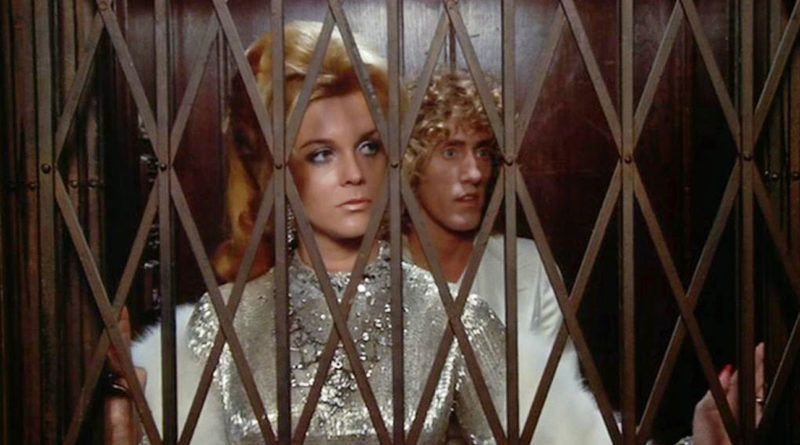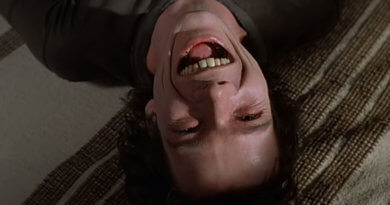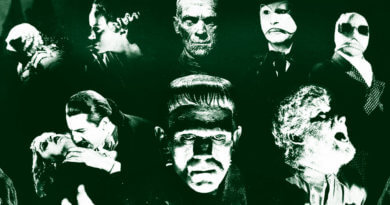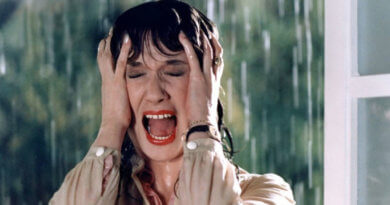The Wild World of Director Ken Russell
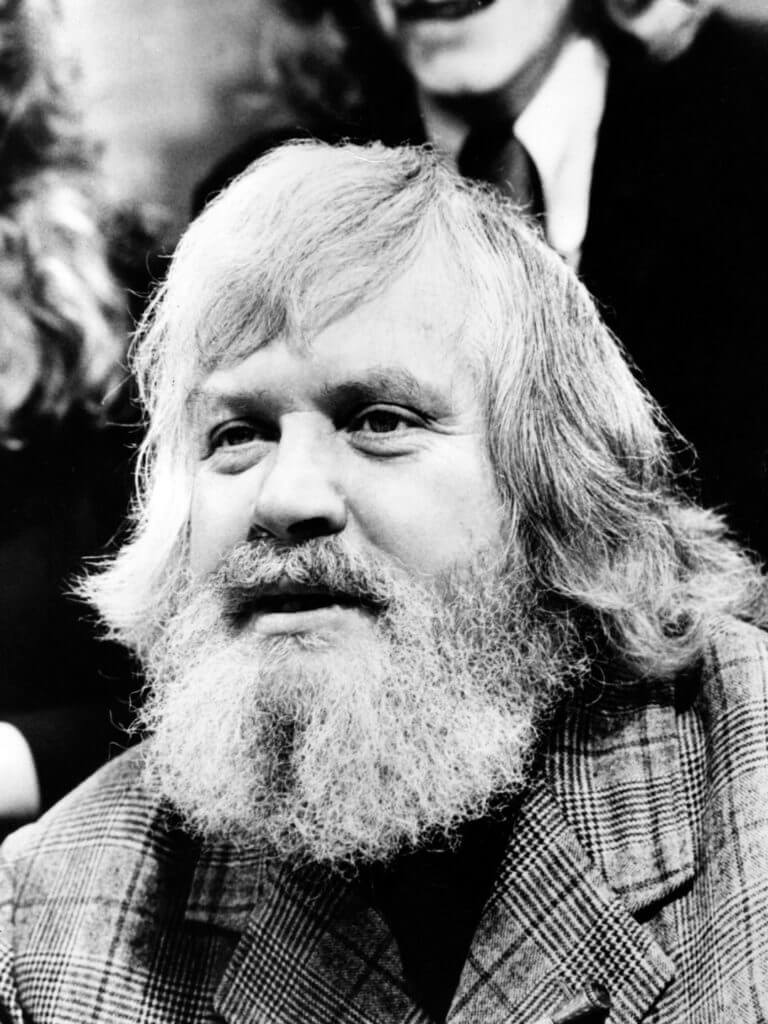
Of all the directors whose names are synonymous with their unmistakable style of filmmaking (Hitchcock, Bergman, Spielberg), perhaps none is as polarizing as wild man Ken Russell. You either love him or hate him. I happen to love him.
Certainly, he was inconsistent. He followed up his master musical Tommy (1975) with the lame Lisztomania (also 1975). Years after his sleaze masterpiece Crimes of Passion (1984), he ripped himself off with the ridiculous Whore (1991), also released under the even more absurd title If You’re Afraid to Say It…Just See It.
But when he was good, there was no one who could compare to him. Nobody heaps on the hallucinatory visuals, wild set decor and stylized acting like Russell. Even Monty Python had fun sending him up in a spoof:
One of his favorite sequences is to begin on a tight closeup of a strange-looking person (often singing) and then smash-zoom out to reveal an entire tableau of oddities.
But he was also capable of producing extremely literate works. His biopics of classical composers (The Music Lovers, Mahler) are amazing, and his adaptations of D.H. Lawrence’s Women in Love (1969) and the 20-years-later sequel The Rainbow are equally memorable.
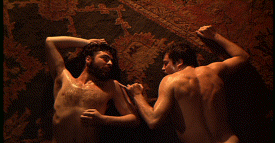
Women in Love was quite controversial upon its release due to the infamous nude wrestling scene between Oliver Reed and Alan Bates. How times change — it recently aired on TCM with the genitalia intact under the relatively mild TV-14 rating!
Glenda Jackson won the Best Actress Oscar for her performance as the cold-blooded Gudrun, who drives Gerald (Reed) to suicide. Not only does it contrast the stories of two couples, it adds an unrequited love story between the two men. The dialogue is symbolic and over-the-top, but in Russell’s world, it works. Reed and Jackson were part of Russell’s informal troupe of regulars, and they would appear in many of his films.
Of the notoriously problematic Reed, who sadly succumbed to alcoholism, Russell said that instead of elaborate direction, he would simply ask for “Mood One,” “Mood Two” or “Mood Three” from him. But it worked — certainly both Reed and Jackson’s performances for Russell rank among their best.
1970’s The Music Lovers tells the story of Tchaikovsky (Richard Chamberlain) and his troubled marriage to Nina (Jackson). As Russell himself said, “It’s the story of the marriage between a homosexual and a nymphomaniac.” Christopher Gable, another Russell regular, plays the object of the composer’s lust, and the most memorable scene involves Nina, who’s gone out of her mind, giving her body to the eagerly groping inmates of the asylum she’s been committed to. It’s also a sublime marriage of filmmaking and classical music.

The Devils (1971) is Russell’s most notorious film, a deeply personal indictment of organized religion (even though he’d converted to Roman Catholicism in 1958). Vanessa Redgrave stars as Sister Jeanne, the disfigured head of an order of severely repressed nuns, and Reed is Grandier, the priest she secretly lusts after. Redgrave’s performance is really creepy; she does a wonderful job of showing the conflicting sensations that pass through the physically and emotionally crippled nun’s mind.
Butchered by censors for its blasphemous content, its most famous sequence — featuring naked, hysterical nuns raping a life-size statue of Christ — is still pretty shocking. It’s packed with other scenes of torture and barbarism at the hands of pious hypocrites.
Strong stuff, for sure, but it deserves much more recognition than it’s ever gotten. The U.S. Warner Home Video release was heavily edited, but there are more complete “gray market” DVDs of varying quality available. I got a pretty decent copy from the late, lamented Luminous Film and Video Wurks, which was a resource of hard-to-find, uncut horror back in the day.
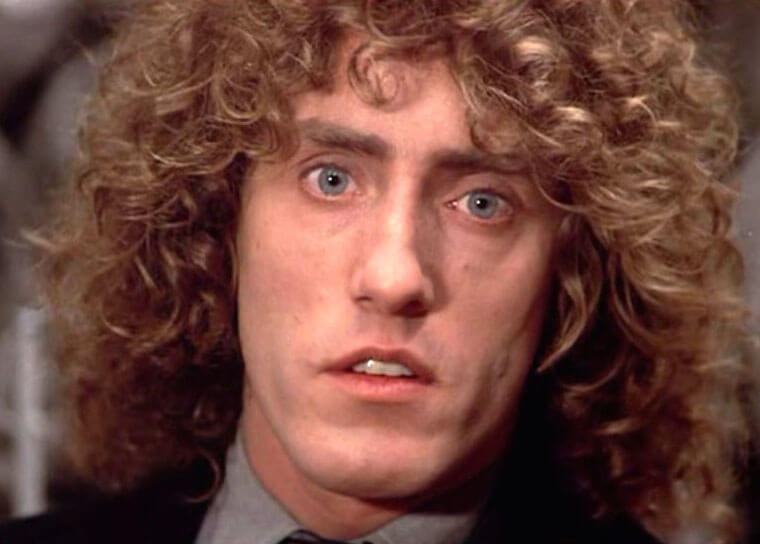
Probably his most successful film in terms of boxoffice was 1975’s Tommy, featuring a fearless performance by Ann-Margret and a surprisingly competent one from The Who’s frontman Roger Daltrey.
Russell and this rock opera were a match made in Heaven. Packed with wild visuals to accompany the musical numbers, it’s still great entertainment after more than 40 years. And Pete Townshend made the smart choice to speed up the music and give it more punch for the film. When I heard the original version (after I saw the film), I was shocked at how slow and dull it sounded.
Who can forget the star-studded musical numbers? Eric Clapton’s “Eyesight to the Blind” with the Church of Marilyn Monroe; Tina Turner tearing it up as the Acid Queen (love that distorted mouth-twitching closeup!); Keith Moon as Wicked Uncle Ernie and Elton John as the Pinball Wizard. Jack Nicholson shows up as the doctor Tommy’s guilt-ridden parents take him to, and he can’t sing worth a damn — but it fits into the crazy framework.

1980’s Altered States did well at the box office, but Russell’s behavior on set and battle with the film’s screenwriter, Network‘s Paddy Chayevsky, caused him to become a pariah in Hollywood. However, his last American film, Crimes of Passion (1984), showed that he could still do controversial with the best of them.
Crimes is the story of a seemingly squeaky clean architect by day (Kathleen Turner) who dons a white wig and becomes a sleazy prostitute at night. She’s being pursued by a kinky, insane, poppers-huffing street preacher (Anthony Perkins), who wants to “bring her to Jesus,” i.e., kill her. It includes some of the most explicit sexual content seen in a non-pornographic film, including a cop being sodomized by his own nightstick.
Turner is sexy and sleazy; she wouldn’t show her wild side quite this way again until her sensational turn as John Waters’ Serial Mom (1994). Perkins plays the preacher as if Norman Bates had moved to the big city and fallen into a life of dissolution, which isn’t a bad choice. Russell stages it all in an obvious, exaggerated, studio-bound milieu. Crimes of Passion was one of the first films to be offered on home video in two versions: there was the R-rated cut (in the blue box) and the steamy unrated cut (in the red-hot box).
Happily, a home video company that had branched out into theatrical releases (the sadly long-gone Vestron) offered Russell a multiple-picture deal in the latter part of the 1980s, all made on his home turf, resulting in a couple of somewhat diverting peculiarities (Gothic and Salome’s Last Dance), another nice D.H. Lawrence adaptation (The Rainbow) and one bona fide cult classic (Lair of the White Worm).

Lair of the White Worm (1988) stars Sammi Davis, Catherine Oxenberg, Hugh Grant, Peter Capaldi and the incomparable Amanda Donahoe as Lady Sylvia Marsh, the mysterious, sensuous, snake worshipping aristocrat whose arrival in a small country village causes no end of trouble.
This film also finds Russell in one of his most cheery moods. Though it contains numerous sexual and blasphemous scenes, both the director and his actors seem to be having a wonderful time.
Much of the dialogue is extremely English countryside (someone even asks, “Are we playing ‘happy families’?”) and the match-ups between the snobbish Lord D’Ampton (Grant at his most hilariously arch) and Lady Sylvia are a riot. A sample bit of dialogue:
Lord D’Ampton: Do you have any children?
Lady Sylvia: Only when there are no men around.
Lady Sylvia also has the ability to sprout gigantic fangs at will and can spit venom a good ten feet. Oh…and she is also “charmed” by music.
In the last decade, Russell had gone into making television movies (where he first started), online videos and even written a column for The Times. He was an exhibited photographer and published author. In 2008, he returned to New York to direct an off-Broadway production of Mindgame, a thriller starring Keith Carradine.
At age 83, the year before he died, he showed no signs of losing his taste for the outrageous. This quote from the master himself really says it all:

